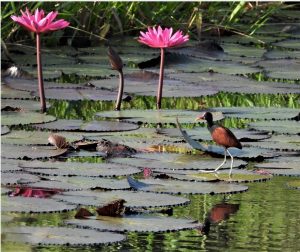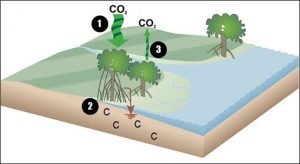What is a Wetland?
Areas where the soil isn’t porous enough for water to be absorbed is considered a wetland. This means that the spaces between the soil particles are small and retains water. Therefore, the ground in wetlands become saturated or full of water and the land does not drain well. Wetlands can have varying water types such as freshwater, brackish (partly salty) and saline (very salty) and are usually classified as swamps, marshes, bogs. Each type of wetland has different types of soil and plants, some unique to a specific wetland.
There are three (3) major wetlands in the island of Trinidad and Tobago, that are internationally recognized; these are
- Nariva Swamp
- Caroni Swamp
- Buccoo Reef Bon Accord Lagoon Complex (Tobago).

Figure 1: Typical Flora and Fauna for a Wetland (Jagai, 2021)
Importance of Wetlands
Locally these wetlands host a habitat for a wide array of biodiversity (animals, plants, bacteria, and fungi) upon which communities and animals (insects, birds, fish, and amphibians) are reliant for food. They also provide a source of eco-tourism to citizens which are currently facilitated by conducting bird tours (e.g., Caroni Bird Sanctuary), through the Caroni and Nariva Swamp and glass-bottomed boat tours of the Buccoo Reef. Wetlands not only play an important role for humans but also to the environment.
Examples of the important role wetlands play to the environment can be summarized as follows:
- Enhance water quality: Wetlands act as a water purifier by trapping sediments and removing pollutants.
When a channel of water flows over the land surface via run-off and enters a wetland, the water stretches out and flow through impenetrable vegetation. This causes friction thereby reducing the velocity of the flow, allowing for suspended pollutants to settle to the wetland surface. The soil holding the plants will act as a sponge and absorb the contaminants. This certainly reduces the need for expensive, man-made filtration systems.
- Control erosion: Erosion is the gradual destruction due to water, wind, and other natural factors.
There are two (2) ways in which wetlands serve to control erosion and that is by acting as a shield when waves come crashing into shore or water running down a slope. Additionally, the plants are locked into the soil with their roots which makes it more stable and rigid and are less likely to be carried away by water running down the hill.
- Store carbon: Wetlands can store atmospheric carbon released in the form of carbon dioxide (CO2) in plant biomass (dead leaves, branches, and roots) and soil.
The main pathways in which carbon moves into and out of wetland areas are:
- CO2 in the air gets absorbed by the plant biomass via photosynthesis.
- Dead plant biomass containing the absorbed carbon gets buried in the soil and covered with water. Typically plant roots undergo a cycle, they form, die, and are replenished by new roots over short periods of time. Wetland soil is anaerobic (without oxygen) therefore, dead roots would decompose slowly resulting in a significant accumulation of carbon.
- Loss of carbon occurs via respiration in the water cycle (every time organisms take in glucose in the form of food and breathe in oxygen, they exhale carbon dioxide, water vapor and energy).
As you can see wetland ecosystems is essential for combating climate change.

Figure 2: Illustration of the mechanisms by which carbon enters and exits wetlands (Howard et al., 2017)
- Protect against flooding: When an area becomes flooded with water, wetlands act as a sponge by taking up excess water and preventing any movement to surrounding housing areas. Also, trees, roots and other wetland vegetation slow the speed of flood waters.
- Provide wildlife habitat: Provide a home to at least one third of all threatened and endangered species.
What is World Wetlands Day?
All these examples are to remind us, that wetlands are of vital importance to the world today and we must continue to preserve and manage this resource. Trinidad and Tobago joined the Global Community since 1993 in commemoration of World Wetlands Day.
February 2nd was selected as it coincides with the anniversary date of the adoption of the Convention on Wetlands on February 2nd, 1971, in the Iranian city of Ramsar. The convention then came to force in 1975.
It is a very important date on the calendar of wetland conservationists, as it serves as the platform to communicate and promote public awareness of wetland values and their benefits. The theme for the 2022 is “Wetlands Action for People and Nature”, and it highlights the importance of actions that ensure that wetlands are conserved and sustainably used. It provides the community and government members to invest financial, human, and political investment towards saving the world’s wetlands from disappearing and to restore those we have degraded.

Figure 3: Logo for World Wetlands Day (Aula Verde e Blu di Mola., 2022)
Human and Natural Impacts
There are many factors that cause wetlands to degrade with time, but it can simply be classified into human impacts and natural impacts. However, humans have had more of a significant impact in affecting our wetlands, both positively and negatively.
Human impacts can be categorized into the following:
- Encroachment: This refers to the building of structures, roads, utilities, and other developments, into areas such as wetlands and other surface water areas. These developments can lead to low levels of flow and environmental degradation.
- Pollution: Release of toxic pollutants from industrial waste, extracted minerals and peat, pesticides released from nearby farming and discarded litter. As well, grazing of domestic animals has impacted our wetlands. When animals excrete waste near the wetlands, it causes toxins to go in the water and grazing erodes the natural land causing sedimentation to enter the wetlands
- Increased water consumption: One of the largest problems for wetlands is caused by reduction in the level of the water table. The amount of water being taken from the underground aquifer is too much to be replaced. This is causing stress on wetland ecosystems and is depleting the amount we see today.
Human impacts cause many problems to our wetlands, but they are not the only cause. Natural impacts also play an important role in discovering how badly our wetlands are treated. Two (2) main natural factors that can impact wetlands are sea-level rise and natural disasters such as hurricanes and storms.
Sea-level rise is an effect of climate change and increases on a yearly basis as humans continue to emit greenhouse gas emissions into the atmosphere. When sea levels rise as rapidly, even a small increase can have devastating effects on coastal habitats farther inland, it can cause destructive erosion, wetland flooding, aquifer, and agricultural soil contamination with salt, and loss of habitat for fish, birds, and plants. Therefore, the gradual rise of sea level per year, has the potential to both increase wetland size by periodically flooding low-lying uplands and to destroy vegetated wetlands by increasing water depths.
What can we do (as individuals) to positively impact wetlands?
As much as the wetlands are places of recreation and pleasure, they are also hosts that support our ecosystems, diverse wildlife, and their habitats that forms a unit which rely on each other and in return support the environment. They require our care and attention.
Here are ten (10) simple things we can do to help maintain our wetlands:
- Practice proper care of household plants and gardens: Replace use of chemicals used in plants such as fertilizers, pesticides, insecticides, or fungicides with organic remedies instead. When rain falls it can carry away these chemicals which can leach into groundwater, and subsequently into wetlands.
- Supervise pets and monitor pests: Animals such as cats are known to prey upon species such as frogs, lizards, or turtles. Rabbits can also binge on plants and hinder any fresh regrowth by spreading feces which can cause weeds. Therefore, it is best to keep pets indoors and under supervision. They are likely to cause less harm if they are not allowed to stray.
- Waste and Recycling: Limit the use of plastic (plastic bottles, containers, straws, and cutlery) and practice safe methods of waste disposal (reuse and recycle to the maximum possible extent). A sustainable way of reusing waste (cardboard, paper, eggshells, and tea bags) is to convert into compost for your garden.
- Minimize Pollution: Reducing pollution can begin at home and other organizations with some relatively small but consistent steps. Consider buying organic, eco-friendly, and sustainable products. Be energy-conscious and use energy wise appliances. Avoid throwing away stuff carelessly. If you find litter in public places, take the initiative to throw it away in the bin.
- Conserve Water: Wetlands play a key role in recharging our groundwater aquifers which the population relies on for drinking water and irrigation. But this water is also central to wetland health which can be preserved by conserving water. Turn off the tap when not in use and use only as much as you need. Check your pipes and fittings regularly for any leakages. Harvest rainwater.
- Healthy Wetland Vegetation: Healthy vegetation is crucial for sustaining life in the wetlands. You can help in the conservation and rehabilitation efforts – by planting native flora, creating habitats for wildlife.
- Help Wetland Wildlife: Much like the wetland vegetation, wetland wildlife too is exposed, fragile and susceptible. Turtles that live in the swampy wetlands are known to venture out, cross busy roads or polluted areas in search of suitable nesting sites. Accidents are common and animals get run over. It is also common for animals to get entangled and hurt in the plastic debris. Animals sometimes venture into homes and gardens, looking for nesting sites or grounds to lay eggs. There are many ways in which we can help these animals, by looking out for them, helping them get to their destination and protecting their eggs or hatchlings. Apart from the permanent wetland residents, some migratory birds use the wetlands for resources. The dwindling bush and fringing vegetation and the changing environmental conditions are posing a serious threat to all their lives.
- Important Contact Information: It can be useful to locate and carry information on local bodies responsible for wildlife rescue, wetland rehabilitation and conservation work, and research organizations. This can be especially significant if you reside in an area close to wetlands.
- Learn and Educate: Sign up for entry level courses so you more fully understand the factors that impact the wetlands and what practices you can adopt. Where possible, share your information and experience with your family and co-workers.
- Participate and Volunteer: Host community- based outreach programs that work towards spreading awareness of the threats posed to wetlands and conduct maintenance such as cleaning up litter.
References
- All Answers Ltd. (2021, December 31). Impacts Of Urban Development On Wetlands Environmental Sciences Essay. Retrieved from https://www.ukessays.com/essays/environmental-sciences/impacts-of-urban-development-on-wetlands-environmental-sciences-essay.php
- (2022, January 4). how do wetlands clean water. Retrieved from https://lisbdnet.com/how-do-wetlands-clean-water/
- Krauss, K. W., Zhu, Z., & Stagg, C. L. (2021, November 16). Managing Wetlands to Improve Carbon Sequestration. Retrieved from https://eos.org/editors-vox/managing-wetlands-to-improve-carbon-sequestration
- Nunez, C. (2021, May 3). Sea level rise, explained. Retrieved from https://www.nationalgeographic.com/environment/article/sea-level-rise-1
- Wetland Disturbance and Impact. (n.d.). Retrieved from https://mde.maryland.gov/programs/Water/WetlandsandWaterways/AboutWetlands/Pages/disturbance.aspx#natural
- Kanchi, L., & Kanchi, V. A. P. B. L. (2018, August 28). 10 Things You Could Do To Help Our Wetlands – The Wetlands Centre. Retrieved from https://www.thewetlandscentre.org.au/blog/things-to-do-to-help-wetlands/
